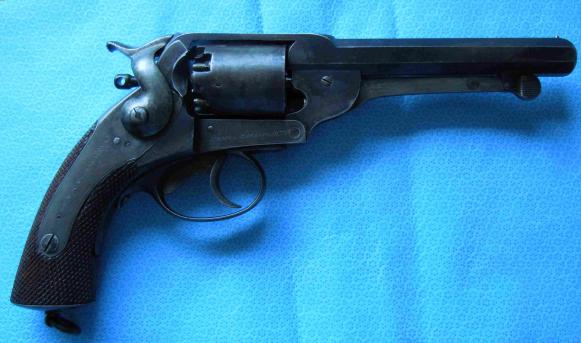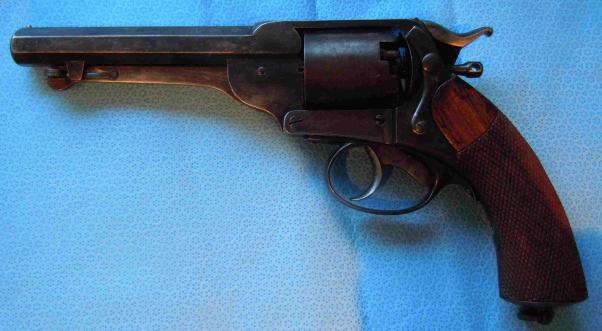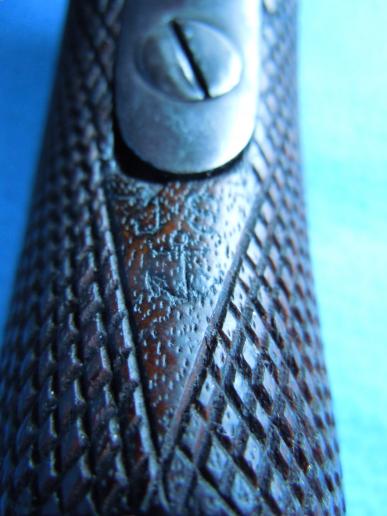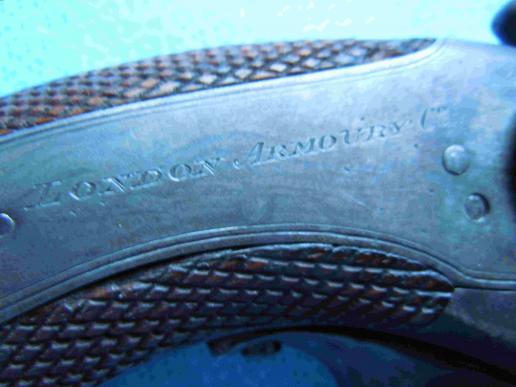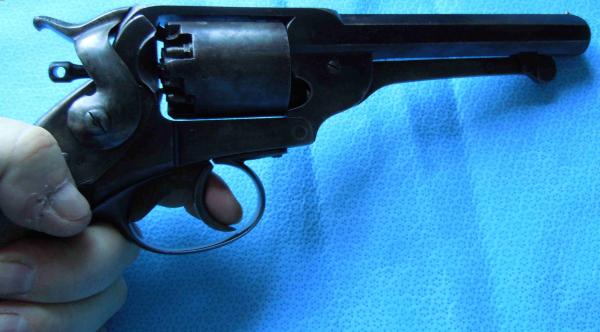Fine Civil War Kerr Revolver
This is a fine example of a Civil War era Kerr revolver in 54 bore (.44) and is a good looking specimen. This particular revolver is mechanically crisp, rotates and locks tight and has a good bore, around 40% of the original finish remaining and good intact grips which are often seen the worse for wear but not on this one. It also features the anchor importation mark on the butt which is considered to be the evidence of an importation by the Confederacy. The lanyard ring also gives credence to the fact that this was manufactured against a military requirement. This revolver originated in the USA on a recent trip so I would consider it as highly likely to be a Confederacy weapon. This isnt the best Kerr I have seen but certainly I would place it in the top 20% and I can report no defects. There are fake anchor marks extant particularly in the USA but the vendor did not point out the mark to me as it is not bold and I dont think it had been noticed as he was not a specialist collector but I noticed the mark and inspection with a digital microscope assures me that it is an old mark and not a recent improvement which sadly is becoming more of a problem in this business.
The Kerr Revolver featured a side-mounted hammer on a back-action lockplate. Unlike other revolvers of the day, the lock mechanism of the Kerr revolver was identical to that of back-action rifle and single shot pistol percussion locks of the time. The simple action was designed to be easily repairable in the field without requiring model-specific spare parts. The Kerr had a top strap over the cylinder, which is held in place by a pin that runs into the back of the frame below the hammer. The pistol is 12.25 inches overall with a barrel length of about 5 inches. Nearly all were made in .44, or "54 bore", calibre; a few in the smaller .36 calibre.
James Kerr had been the foreman for the Deane, Adams and Deane gun factory. Robert Adams, one of the partners and inventor of the Adams revolver, was Kerr's cousin. Kerr developed an improvement to the Adams revolver, British Patent No. 1722 of July 28, 1855, and when Adams left the Deane brothers to found the London Armoury Company on February 9, 1856, Kerr went with him. The London Armoury Company manufactured military rifles and revolvers. Kerr designed rifles for the company based on the 1853 pattern Enfield rifled musket. When the company directors decided to focus on rifle production in 1859 Adams left, taking his revolver patents with him.
Kerr designed a new revolver in .36 calibres and .44 calibres (54 bore). Production began in April 1859. The British government did not initially purchase the weapon and civilian sales were modest. All the New Zealand revolvers were 54 bore (gauge) or .44 calibres.
However, the U.S. Civil War began in 1860 and the governments of both the United States and the Confederacy began purchasing arms in Britain. In November 1861, 1,600 revolvers were purchased for the Union army, at $18.00 apiece. However Confederate arms buyers Maj. Caleb Huse and Cpt. James D. Bulloch contracted for all the rifles and revolvers the Armoury could produce (and the Confederate government could pay for). As a result, the London Armoury Company became a major arms supplier to the Confederacy, selling the most of the 11,000 Kerr revolvers produced to Huse. The Kerr revolvers sold to the Confederacy are now thought to range between serial numbers 3,000 and 11,000, but earlier serial numbers are thought by collectors to have also been shipped to the South, and there are no good records to show the exact number sold to the Confederate buyers.
As with all Confederate imports from England (and Europe), these weapons had to pass through the Union blockade and the number that actually reached the Confederate army is unknown. Modern writers often state that the Confederates acclaimed the London Armoury Company's guns (which would include the first-class model 1853 rifle-muskets on the Enfield pattern) as the best weapons delivered to the Confederacy. The London Armoury Company supplied more revolvers to the Confederacy than the total produced by all the efforts of Southern manufacturers to make revolvers.
As the Civil War progressed, the London Armoury Company was almost completely dependent on sales to the Confederacy and survived for only a year after the end of the war, dissolving in the Spring of 1866.
A fine and interesting revolver and a very pleasing example.
Code: 50225

